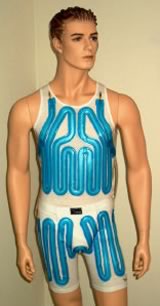New Trends in Infantry Gear
A typical system is the thermal vest developed by TPI. The system is designed to be worn under body armor and/or CB protective ensembles. This modular system consists of a wearable underwear garment including shorts, vest and other elements such as sleeves or helmet liner. The garment has coolant lines embedded into flat laminate with each channel, containing a ribbon of closed cell foam. These lines are connected to a temperature controlled fluid supply and conditioning. For a heat transfer fluid, the system uses drinkable water contained in a ‘camelback’ style back-pack integrated with a hydration system supplying cold drinking water to the soldier. The combination of shorts and vest provides optimal cooling flow over most of the body’s large muscle groups and major organs. When a helmet liner is added, cooling the head and neck, an optimal conditioning can be achieved. The system’s dry weight is only 3 pounds. When loaded with water sustaining 500 W/h capacity (4 hours operation at 125 Watt) the system’s weight is about 15 pounds, including a quart of cold drinking water which can be consumed without affecting the cooling system. The system is powered by four AA or C cells, depending on life requirements.
The back pack contains the system support assembly: the pump, battery pack, control valve and heat exchange/hydration bladder. This assembly fits into a standard 100-oz hydration back-pack (such as Camel-bak, Platypus, Hydrastorm, etc.) or can be integrated into a standard combat or assault pack. An important feature is the The incorporation of the hydration function into the cooling system is a significant advantage for the TPI system, saving considerable weight of the total combat load.
Using a large bladder up to 100 oz. could provide up to 30 to 40oz of cold drinking water while the remainder of the fluid continues to support the cooling function throughout the mission.
The cooling vest decapitates over 125 watts of metabolic heat. Adding the shorts and helmet liner for use under intense heat, increase the system’s performance well over 200 Watts. Furthermore, the system is automatically controlled to sustain the required temperature to extend operational endurance. For example, a 500 Watt/hour capacity system could extract 125 Watt for 4 hours or 65 Watt for approximately 8 hours.
In this series Defense Update covers the following topics:
















